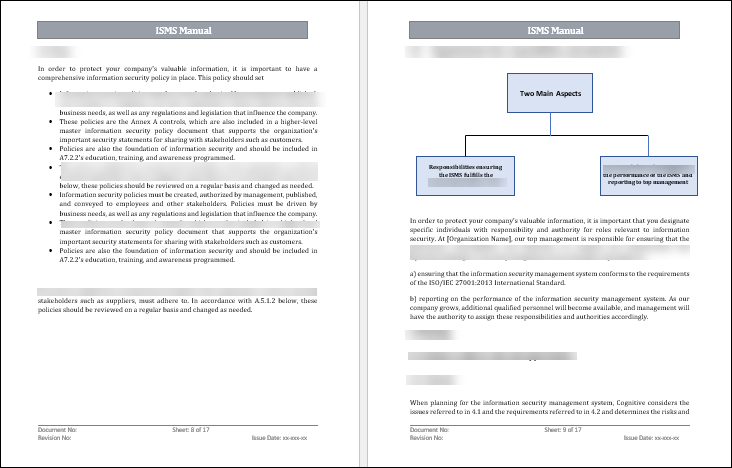ISMS Manual Template Download
The International Organization sets the ISO27001 standard for information management systems for Standardization. The standard provides a framework organization can use to create, implement, and maintain an information management system. Each clause addresses a specific aspect of information safety. The standard also contains several Annexes that provide additional guidance for specific topics, such as choosing an information security system.

ISMS Components
This blog will provide a basic security policy for an Information Security Management System. This policy will cover the key components of an ISMS, including confidentiality, availability, and integrity. We will also discuss risk management and its importance in an ISMS.
1. Confidentiality: Information Security Policies and Procedures should be designed to guarantee the confidentiality of information. Information security is dependent on the confidentiality of data. The information must be kept confidential to prevent unauthorized access or disclosure. To ensure data confidentiality, information security policies and procedures must be developed.
2. Integrity: It is crucial to an ISMS's security. Validity requires that the information is accurate and complete. To ensure the integrity and accuracy of information, policies, and procedures relating to information security should be developed.
Information accessibility is crucial to the security of an ISMS. Information must be readily available to be of any use. Information security policies and practices should be designed in a way that ensures the availability of data.
3. Risk Management: Risk management plays a vital role in the security of ISMS. To protect against unauthorized access, disclosure, or destruction of information, risks must be identified. The ISMS should integrate risk management into every aspect of the ISMS.

What Should Be Included In An ISMS Manual?
1. Understand Stakeholder's Needs- Understanding the needs and interests of interested parties is a key requirement for implementing an ISMS. First, identify the stakeholder. This includes customers, suppliers, and employees. After identifying the stakeholders, the next step involves understanding their needs and requirements. This can be done through interviews, focus groups, and surveys. After identifying the needs of stakeholders, it is time to create a plan that addresses those needs.
2. Roles and Responsibilities Of Organizations- Employees in every organization must adhere to certain duties to maintain an efficient and productive workplace. Employees can understand what is expected from them by understanding their responsibilities and be held accountable for not meeting these expectations. Organizations can also use this manual to set priorities, make decisions on staffing and other resources, and as a guide.
3. Information Risk Assessment- Every organization has a set of responsibilities to which employees must adhere to maintain an efficient and productive workplace. Employees can understand what is expected from them by understanding their responsibilities and be held accountable for not meeting these expectations. Organizations can also use this manual to set priorities, make decisions on staffing and other resources, and as a guide.
4. Information Risk Treatment- The process of identifying and assessing risks to information assets, as well as implementing appropriate responses, is known to be Information Risk Treatment. It aims to protect assets and ensure they are readily available. Information security management is not complete without information risk treatment. Information risk treatment involves four steps:
- Identify risks associated with information assets.
- Information assets are at risk.
- Information assets are at risk.
- Monitor the effectiveness with which you respond to risks to your information assets.
5. Operation Planning And Control- Although there is no one-size-fits-all approach to ISMSs, some elements are common. To have a successful operation planning and controlling process, the first step is to create a concise and clear statement of your organization's objectives. All stakeholders should contribute to creating this statement, including senior managers, employees, shareholders, and customers.
6. Performance Evaluation- ISMS policies, procedures, and controls are used to manage information security risks. Performance evaluation is a vital component of any ISMS. Performance evaluation is used to evaluate the effectiveness of an ISMS and identify areas for improvement. Implementing an ISMS can provide several benefits. These benefits include increased security, reduced cost, improved compliance, and enhanced reputation.
7. Nonconformity & Corrective Action- The first step to corrective actions is identifying a nonconformity. A nonconformity can be any part of an ISMS which does not meet the specified requirements. A nonconformity must be identified and documented. Corrective actions must then be taken to correct the problem and avoid it happening again.
The Benefits Of An ISMS Manual
- ISMS manuals provide organizations with an understanding of security controls. Security controls are policies and procedures that organizations use to protect their data assets. Understanding security controls in detail will help organizations implement them more efficiently. A manual on ISMS can also help organizations troubleshoot security control issues.
- ISMS Manual also guides how to handle security incidents. Security incidents can threaten an organization's confidentiality, integrity, or availability. By understanding how to handle security incidents, organizations can mitigate the impact more effectively. A manual on ISMS can also help organizations to plan and implement a successful recovery after a security event.
- A manual on ISMS can help organizations gain a better understanding of cyber-security risks. A manual ISMS provides an organization with a framework to manage its cyber security program. The manual should be tailored according to the needs of the organization. The ISMS manual of an organization should, for example, address the types and threats to information assets. It should also include the controls to implement to protect these assets.
Conclusion
By implementing this ISMS Manual Template, you not only enhance your information security measures but also streamline your operations. You'll be well-equipped to protect valuable data and sensitive information, building trust with your clients and stakeholders. you gain access to a professionally crafted manual that aligns with industry standards and best practices, saving you time and effort.

